The Accomplished Sailor We Would All Wish To Be
17 December 2021
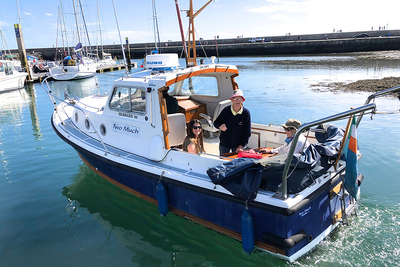
Neville Maguire (1927-2021) was a devotedly local sailor whose racing was at world standard. Yet any civilised sailing enthusiast would wish to be as he was, for although Neville’s racing was important, it was only part of a lifelong love of the sea and sailing that he successfully combined into a warm and devoted family life of several interests. He made the very best of the opportunities offered by the particular and special coastal part of the world where he spent all of his 95 years, while always having a lively and informed curiosity about other places at home and abroad that he might visit
Although his branch of the Maguire family today is closely intertwined with the coast of north Dublin and Fingal between Clontarf and Skerries - with particular emphasis on the Howth peninsula and its harbour together with the islands of Ireland’s Eye and Lambay - he was very much a Maguire of Fermanagh, descended from those pioneers of recreational and ceremonial sailing on Lough Erne way back in the 16th Century.
By 1900, Neville’s grandparents were pioneering a different form of recreational transport – they ran the first bicycle ship in Enniskillen, and were acquainted with John Boyd Dunlop, one of the inventors of the pneumatic tyre. He had been born in Scotland, but gradually made his way south through Ireland via Belfast and Enniskillen until he ended his days in Dublin in 1921.
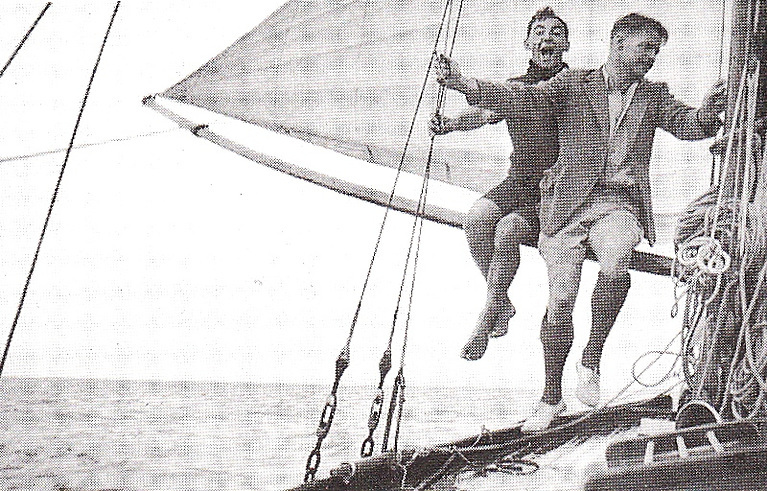
Neville’s father Cecil was also to follow the Enniskillen to Dublin route. His boisterous energy became too much for the enclosed world of Ennisklillen, and things came to a head after the Incident of the Lady of the Lake. In a staid northern town like Enniskilllen on a Sunday, the only thing moving was the paddle steamer Lady of the Lake on her special weekend outing in which the highlight was going through the River Erne in Enniskillen at full speed, with spray flying noisily from the mighty paddle wheels.
THE PADDLE-STEAMER PRANG
Neville occasionally relished telling how Cecil saw possibilities for added entertainment in this display. Apparently one Sunday afternoon he recruited a large group of his school-friends to make the outing, and at the narrowest part of the channel in the middle of town, they were all on one side of the Lady of the Lake when - in unison - they shouted: “Man overboard!!”
All the other passengers naturally rushed to the side of the supposed incident, which heeled the Lady of the Lake so much that while one paddle became even more powerfully immersed, the other was lifted clear out of the water, and she went out of control and up the bank of the Erne. Miraculously, the ship slid back down again with no significant damage. But to have been the cause of such an absurd incident, and in the midst of the northern Sabbath afternoon at that, was simply too much. So it was suggested firmly to young Cecil – aged just 12 – that his future lay in an immediate apprenticeship in the nascent motor trade in Dublin.
It seems that was what he’d hoped for all along, as he made his working life in the car business in Dublin. Although like everyone else in that trade his fortunes waxed and waned, with marriage he acquired a family home in Kilbarrack on the north shore of Dublin Bay just across the then-quiet coastal road from the future site of Kilbarrack Sailing Club, and when Howth Motor Yacht Club was formed in 1934, he was in from the start with a motor-cruiser moored in Howth Harbour.
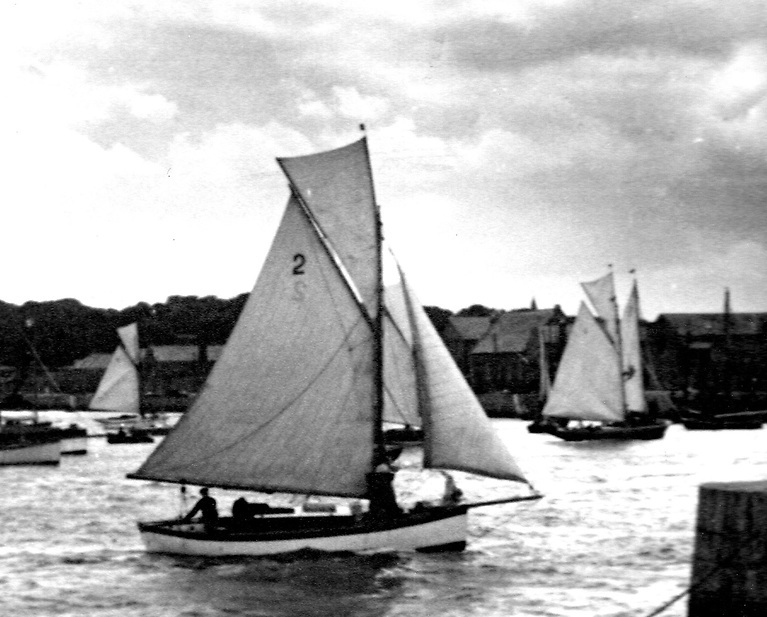
His eldest son Neville had been born in 1927, but when HMYC opened up to junior membership in 1943, Neville was away at school and thus it was his younger sister Sheila who became the first child of the Maguires to join the club in Howth, with Neville joining a few weeks later. It was a fact of which she quietly enjoyed reminding him, but with her death a couple of years ago, Neville clearly became the most senior member of what had become Howth Yacht Club.
And though all the family sailed, Neville’s seniority gave him more varied experiences. His father was among that special group who were the friends of the yacht designer and builder John B Kearney with whom he secured a crewing position for Neville, and in the late 1930s Kearney was at the height of his powers with his famous 38ft yawl Mavis.
THE FAMOUS KEARNEY HOSPITALITY
Because his day job was as the de facto harbour engineer of Dublin Port, Skipper Kearney preferred to do his cruising in Scotland, for he’d found that cruising the Irish coast became a sort of royal progress from one reverential harbour master to another, which wasn’t really a holiday at all. But by the time young Neville made his first cruise aged 13 on the Mavis in 1940, World War II was in progress, Ireland was neutral and under The Emergency, and Mavis had to do all her cruising close inshore along the east and south Irish coasts.
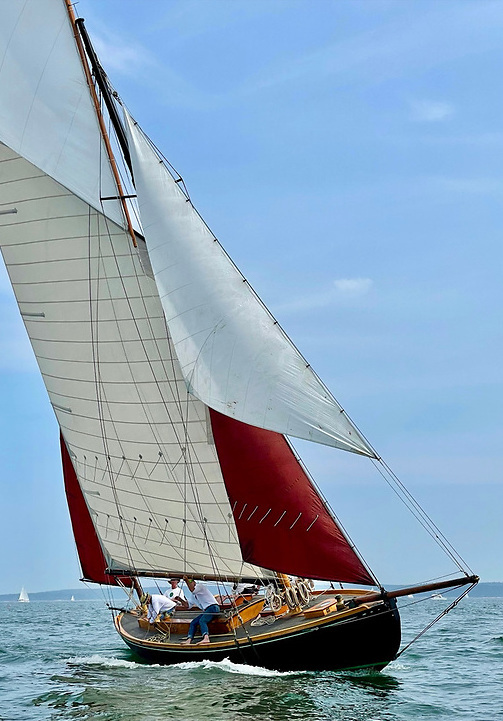
Thus at each port the harbour master would appear on the quayside as Mavis berthed, Skipper Kearney would graciously invite him on board to put the world to rights, and in the notably comfortable saloon Neville as The Boy would be requested to get John Kearney’s personal bottle of Mitchell’s Green Spot Dublin Whiskey from the elegant drinks locker for the skipper and his special visitor’s enjoyment.
The bottle invariably seemed to be about a third full, and the half-hour or so of increasingly entertaining conversation would be charmingly concluded in a flourish with Skipper Kearney holding the bottle up to the light, and observing that they might as well finish it before their special guest went on his way. Then, once they’d seen the Harbour Master safely ashore and well on his way, young Neville’s task was to re-fill the whiskey bottle to exactly the same original level. But much and all as his eyes twinkled in later life recalling this ploy, he never would admit to the rumour that it was no more than standard Jameson put into in the sacred Mitchell’s Green Spot bottle which kept each HM’s length of stay on track.
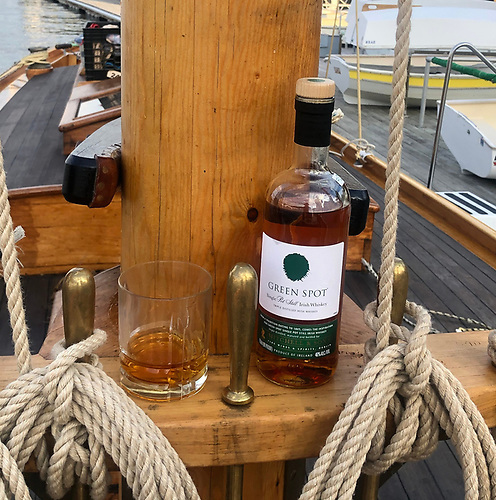
The Emergency meant that fuel was unavailable for motorboats unless you’d inveigled your way into a position of authority with the Maritime Inscription, in which case your boat became a Patrol Vessel, and occasionally used for Night Exercises. In one of these the Howth Group, with its two HMYC motorboats, succeeded in being acknowledged by the referees as having taken over control of Dublin Port, a situation which apparently has never been relinquished.
But Cecil Maguire, being in an anomalous position regarding fuel with his motor car involvement, took a different route by giving up motor-boating for the direction and acquiring the 1894-built 28ft cutter Marie, designed by Maimie Doyle who later designed the Mark 2 Dublin Bay Water Wags. By removing Marie’s propeller, Cecil provided his young but growing family with the regulation-compliant means to develop their sailing skills throughout the war.
INLAND WATERWAYS
In those days young people weren’t treated like a separate species requiring pampering. On the contrary, they were often left to learn skills like sailing on their own. So it was that after the war ended and The Emergency with it in 1945, when Cecil bought the large motor-cruiser Cirrus from her moth-balled berth on the Royal Canal in Lucan, it was assumed that Neville and his younger brother David and some school friends would be well capable of going down to Lucan, commission the Cirrus, and take her on west through the Royal Canal to the Shannon so that the family could enjoy some inland waterways cruising - it was to become another of Neville’s passions – before eventually Cirrus was brought back to Dublin and Howth by the Grand Canal in an early enactment – albeit reversed – of today’s Green & Silver Route.
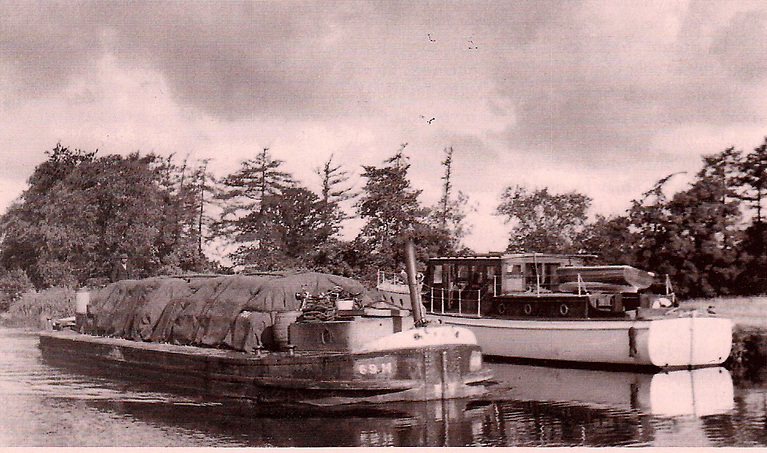
Meanwhile, in Howth, the hefty Marie had been sold as the Maguire boys hoped to get racing with a Howth 17, but the post-war demand was such that none was available. However, when Cecil was in an expansionary mood, there was no stopping him, and as he’d kept up his Fermanagh and Erne connections, he got to hear of a similarly-sized gunter-rigged sloop on the lower Erne at Ballyshannon.
The boat was by this stage called Iolanthe, but as she had an enormous centreplate, she may well have been one of the old Belfast Lough Jewel Class. Be that as it may, there was no way Cecil could convince anyone that she was a Howth 17, but as the performances were broadly similar, Neville Maguire was well on his way to honing his remarkable natural sailing skills when he and his little gang could manage to shadow the Seventeens.
However, as often as not he was frustrated from doing this, although Iolanthe was ideal for day cruising to Ireland’s Eye and Lambay and other places on a varied coastline which Neville Maguire was to continue to enjoy with a quiet passion for another 75 years. But the lack of real One-Design racing became increasingly irksome, and as one of J B Kearney’s dearest wishes was that Howth should become home to a fleet of his 17ft Dublin Bay Mermaids, Cecil readily agreed to buy his sons the Mermaid class Elf, No. 32.
Soon the class at Howth had reached five boats, the number required to be allocated a starting gun. But it got no further. Elf was almost immediately winning everything, and other young skippers lost heart. The class faded away, so Elf’s skipper Neville joined Clontarf Yacht & Boat Club (founded 1875) with one of the strongest Mermaid classes in the country, and the Maguire team found the grown-up competition they craved.
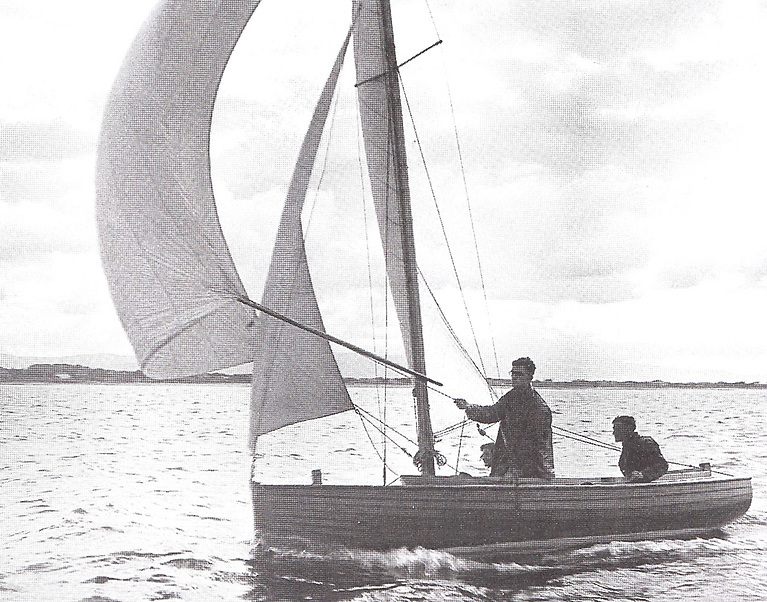
Subsequently, the only Mermaid racing they had at Howth was the annual President’s Trophy during Howth Regatta, when more than 80 Mermaids were regularly appearing with the class at its height. But by this stage Neville was already outgrowing the competition, for he’d been on the national stage with overall victory in the All-Ireland Helmsman’s Championship in 1952 and 1954, and so when a movement got going to introduce the Olympic Finn in Ireland in the 1960s as a viable class drawn from several centres, he signed up.
His personal interest didn’t extend as far as Olympic ambition, as his modest income from his interesting engineering and management job in Perry Greer’s curious industrial mini-conglomerate of Unidare in Finglas didn’t provide an income for such things. Nevertheless, the Finn sailing was quite an undertaking, for in addition to becoming All-Ireland Champion in 1952, in July he’d married Jean McAllister with their first home in a bungalow where Kilbarrack Road – at that time little more than a country lane – came to the shore of the Blue Lagoon inside the Bull Island.
It was a wonderful match, and a fascinating one too, for despite her Scottish surname, Jean’s remote ancestors included the decidedly rugged Elizabethan sea captain Sir John Hawkins as a result of his having been granted conquered land in County Wicklow. Thus any child of Neville and Jean shared the blood of a noted Caribbean buccaneer with the blood of Hugh Maguire, the great sea captain of Fermanagh.
By the mid-1960s their happy union had produced three children – Susan, Leslie and Gordon – who were increasingly interested in having junior boats of their own, so it was quite a stretch for Neville to take on some of the Olympic Finn circuit as well. But back in the mid-1960s most of his fellow Finn sailors were similarly limited in resources, and it wasn’t unknown for them to sleep under a handy roadside tree when on an overnight journey to some distant event.
Among them Neville found someone who particularly sparked his interest, the northern sailor Kevin MacLaverty. The son of the writer Michael MacLaverty, Kevin worshipped the Olympic ideal, and Neville did everything he could to help him get there (which he did in 1972), for Neville was one of the few who were aware that Kevin had a then-inoperable heart condition, which meant that every so often he would have a very brief but total blackout.
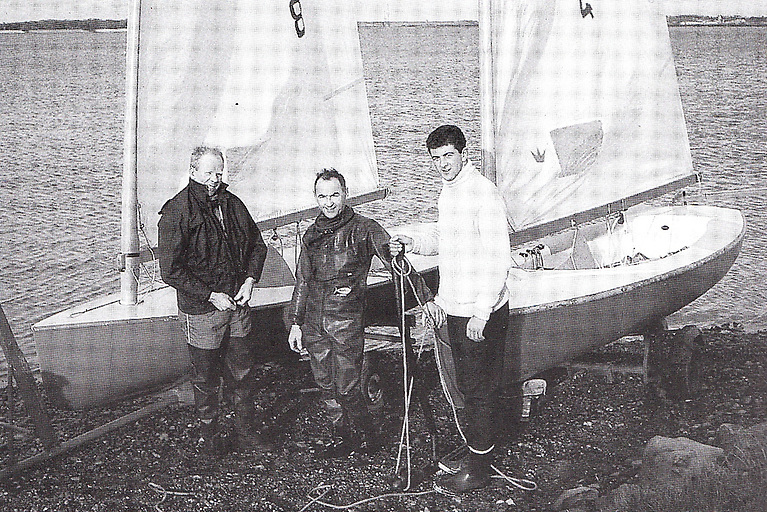
When this happened during racing, Neville somehow managed to be there or thereabouts to keep an eye on Kevin until he recovered and resumed racing as though nothing had happened. But as Kevin’s progress continued satisfactorily up the Finn rankings, Neville was able to dial down his own Finn racing and take up an offer to go into partnership in the Dragon Class Scampi with Ossie Johnston of the Marine Hotel in Sutton.
There’s no doubt that while Neville was a welcome and able crew on a wide variety of boats, he infinitely preferred to sail in complete charge of his own vessel, however modest. But by 1970 the Dragon Class were at one of their peaks, and as Neville drily remarked, the involvement of the Marine Hotel provided useful winter storage space and a ready-supply of user-friendly snacks if they were spending a day away at one of the Dun Laoghaire regattas, or doing his beloved Lambay Race.
As well, Neville was largely left in peace by Ossie to enjoy himself doing the winter refits, and Scampi became renowned for her immaculate presentation each Spring, while in the red-hot Dragon racing circuit in Ireland, she was very much a contender.
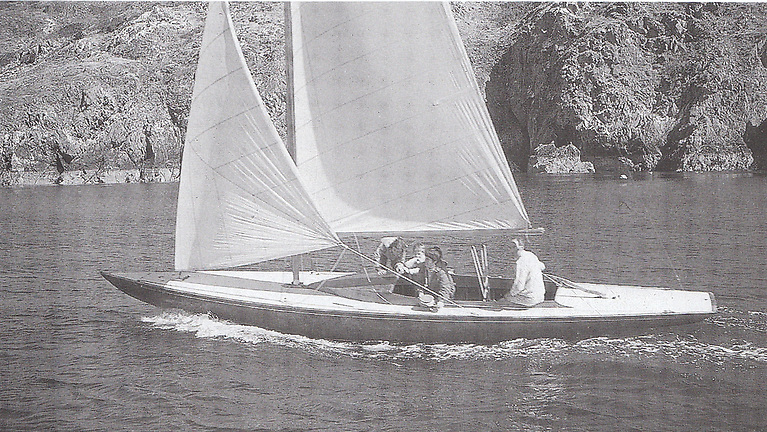
But increasingly Neville found himself drawn to offshore racing, which was very much in a growth phase in the Irish Sea, and with the Scampi partnership drawing to a close and his son Gordon now of an age to have the makings of an albeit very junior crew-member, Neville took himself off to meet Dickie Brown of Weatherly Yachts at Portaferry in County Down, where production of the new Billy Brown-designed Ruffian 23 was getting up to full speed and swelling the offshore fleets at several centres.
Neville Maguire and Dickie Brown hit it off immediately, which was just as well as the Ruffian 23 which Neville and Gordon had in mind was unlike any Ruffian 23 before or since, as great trouble was taken during construction to keep the weight out of the ends, the rudder skeg was done away with, and the rig was a very tall fractional flexible setup which tapered to a needle - all this at a time when practically every serious offshore racer carried a masthead rig with enormous genoas.
With hindsight, the one feature which those of us who built Billy Brown offshore boats of broadly similar hull shape at the time would have found very beneficial would have been twin rudders, for in ultra-gusty conditions, they’d a habit of spinning round to look at you. But in every other way they were up to speed, and Spalpeen – as the Maguires so appropriately named their extremely special Ruffian 23 – was a very complete thorn in the flesh of larger boats for years, both inshore and offshore.
As the activities of the Maguire family continued to expand both afloat and ashore around Howth Yacht Club, so too did Howth itself, and Neville and his siblings had to continually adjust to the experience of having their innocent and rather quaint childhood harbour world being expanded into a modern fishing and sailing port, complete with marina and - in due course - a very modern clubhouse. It was a whole world away from the somewhat rackety setup of the old Howth Motor Yacht Club building on the West Pier, where everything was done - albeit sometimes very slowly – on a voluntary basis, utilizing sometimes extremely vague duty rotas.
For sure, out on the water things were largely as before, and it was almost invariably a Maguire or their extended family who would bring in the first mackerel of each new sailing season, as they’d done since anyone could remember. But the increasing involvement of professional staff in running Howth’s developing facilities always seemed a little strange to them. Yet with the first berths of the new marina opening in 1982, Neville started working out how best he could avail of the changing situation, and in 1983 he acquired the Ron Holland-designed 30ft Club Shamrock Demelza originally owned by the Mansfield family of Crosshaven, which for her time offered an unrivalled combination of good accommodation and very competitive performance.
At much the same period, his longtime friend and sailing rival Harry Byrne acquired Demelza’s sister-ship Rapparee. With similarly-styled livery, they were identical twins to any casual observer who might fail to notice that Neville and Harry used their years-long match-racing situation to pitch one sailmaker against another. But whatever the difference, the boats seemed glued together race after race.
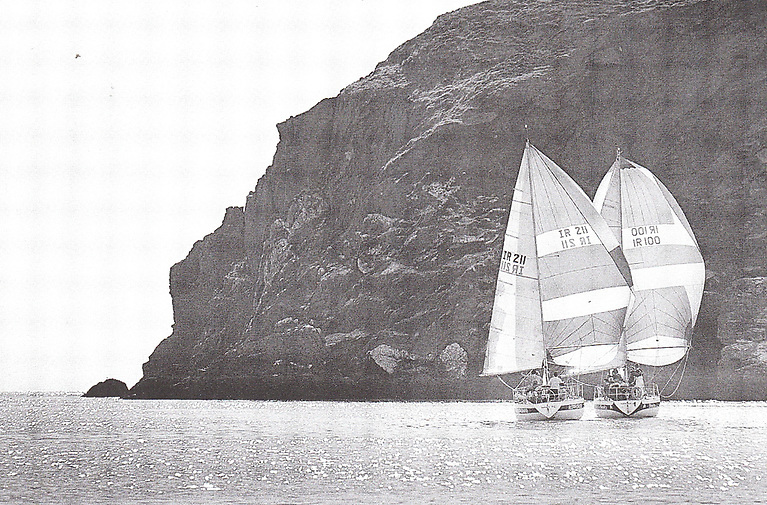
That said, it was an active time and in 1984 Neville with Demelza did the complete ISORA programme. But it was done largely without Gordon, as the latter was exploring the possibilities of Wind-surfing as a possible way into the kind of global competition his exceptional natural sailing talents deserved, at a time when a professional career in sailing was becoming a more attractive proposition with every passing year.
Thus 1984 became an Annus Mirabilis for the Sailing Maguires, for in the final weekend of August, Gordon became the new Irish Wind-Surfing Champion in Kerry, while Neville with Demelza became the ISORA Overall Champion in the neatest possible way, by winning the concluding Abersoch-Howth Race.
To do this by coming first into his beloved home port past Lambay and Ireland’s Eye was very much to Neville’s taste, but in its way 1986 was to be even more outstanding. For although the little Demelza had gallantly done the 1984 Round Ireland Race, it was very much a learning curve experience. But in 1986 they went back with a now more experienced and confident crew, and within sight of the finish line they knew they were within an ace of winning overall. But like many before and since, they discovered that Wicklow keeps a private flat calm at the finish line for those approaching it with great hopes in a usable little sailing breeze, and Demelza sat still for an hour within a stone’s throw of finishing. They still won their class by a significant margin, but were third overall, an hour behind the winner.
By this time, changes in the Maguire family dynamic were taking place. In 1991 Howth Yacht Club played a key role in putting together an Irish team for the Southern Cross Series in Australia, which culminated in the Sydney-Hobart Race. Gordon Maguire teamed up with Kieran Jameson to be helmsman on the chartered 40ft Beyond Thunderdome, and they were top scoring boat until one of the Australian craft dismasted them in a collision in the final inshore race.
Ultimately Thunderdome was awarded complete points compensation, but she was out of the Hobart Race. However, Gordon was immediately recruited aboard the 43ft Atara as helmsman to Harold Cudmore’s skipper, a dream team which saw Atara win the Hobart race overall, the first of several such victories for Gordon who found the Australian sailing scene extremely congenial, and he was set on his course to professional stardom with his home Down Under.
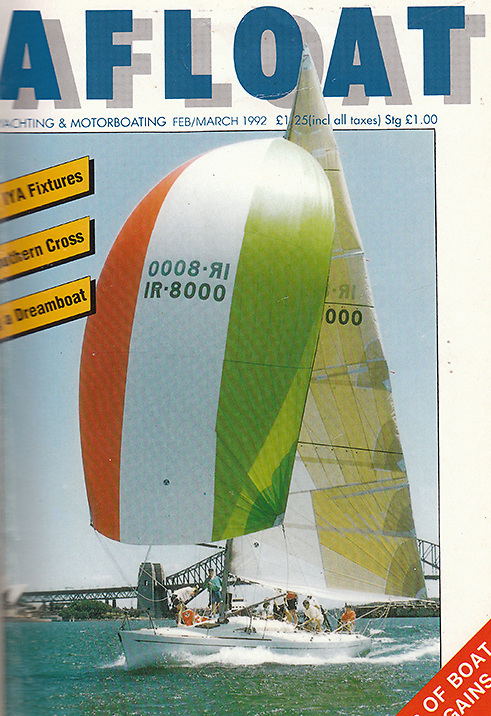
However, such was his international reputation that he frequently appeared home on his way to some major fixture on the European scene, and for their part Neville and Jean visited Australia in addition to expanding their own sailing experiences with friends with boats in the Mediterranean. As well, the inland waterways of Ireland always offered an attractive alternative to any surfeit of salt water, and Neville was probably at his most relaxed cruising with a select circle of sailing friends on the Shannon and its lakes.
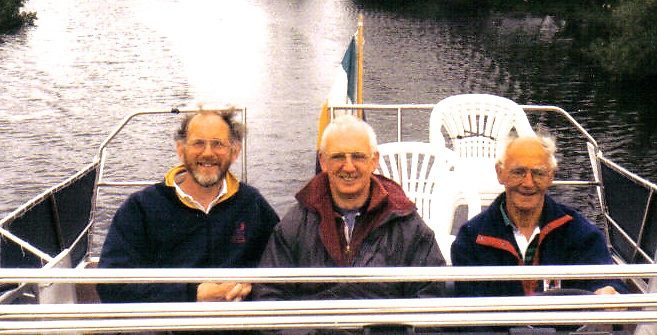
Having had such an extrovert father, it was understandable that Neville was a quietly self-contained individual who didn’t give his friendship lightly. He was the most unselfish of people, as anyone who ever undertook any project with him will attest, but in person he was quietly and confidently self-contained, a thoughtful and sometimes slightly sardonic observer, a doer rather than a talker who found private delight in his hobby of making exquisite model steam engines in his beautifully-equipped workshop, where he derived special pleasure from personally making – from scratch - some tiny little metal fitting which had proved to be unobtainable from even the most arcane suppliers.
Over the years, his time with Demelza was coming to an end as his age advanced and grandchildren and their friends who regularly crewed for him began to leave for college and other opportunities. He was into his eighties and he realised that a well-managed transfer to a suitable small motor-cruiser would be the best way for himself and Jean to continue afloat. Thus Demelza went to Steffi and Windsor in Howth, who aren’t known by any other names, but are the latest distinguished ownership in a golden line which goes right back nearly fifty years to Staff and Mark Mansfield. Neville meanwhile sent his HYC burgee up the little mast of the Seaward 23 Two Much, which was to become a well-used craft.
On one occasion when Gordon was home, they’d the time-honoured jaunt crewed entirely by skippers up to Lambay, where Two Much managed to pick up almost-invisible water-ski line on both propeller, whereupon Gordon was ordered over the side as the youngest on board. As someone more accustomed to swimming at Hamilton Island, it took him much of the day to recover.
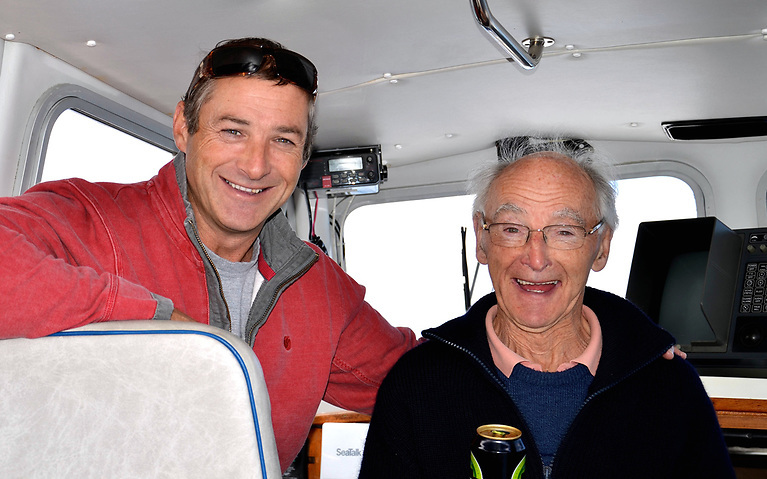
NEW RIG FOR ASGARD
However, even though the pace was slowing, Neville Maguire never lost his many interests, and he always maintained the best quietly impressive pace possible. Thus when Pat Murphy, Wally McGuirk, Paddy Barry and others decided that showing the restored Asgard boringly bare-headed on display in Collins Barracks Museum in Dublin was a missed opportunity, Neville Maguire was one of the key group which came together to give her as much of a rig as was possible within the confines of the headroom, and those involved will never forget the sight of the 87-year-old Neville Maguire atop some rather basic scaffolding, finalising the last details of the shortened mast.
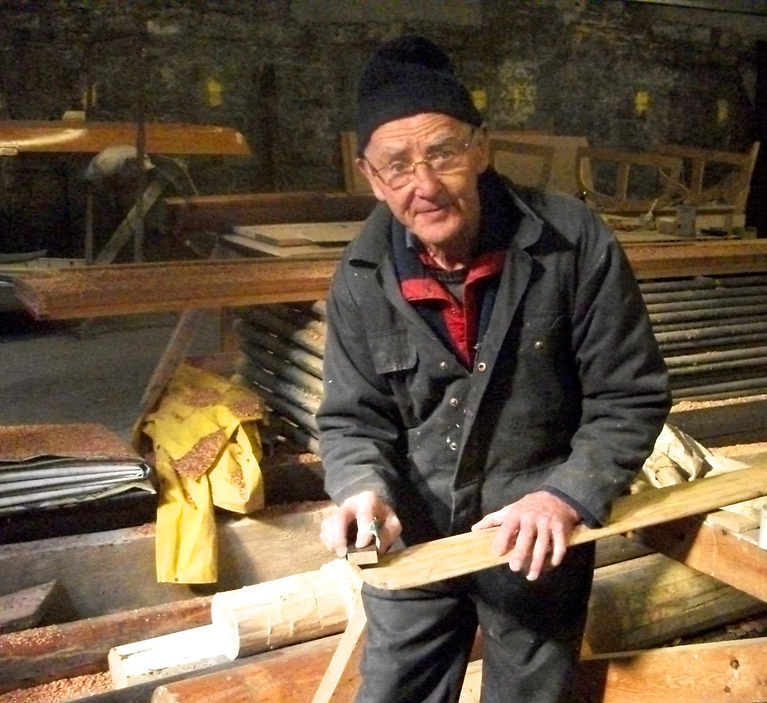
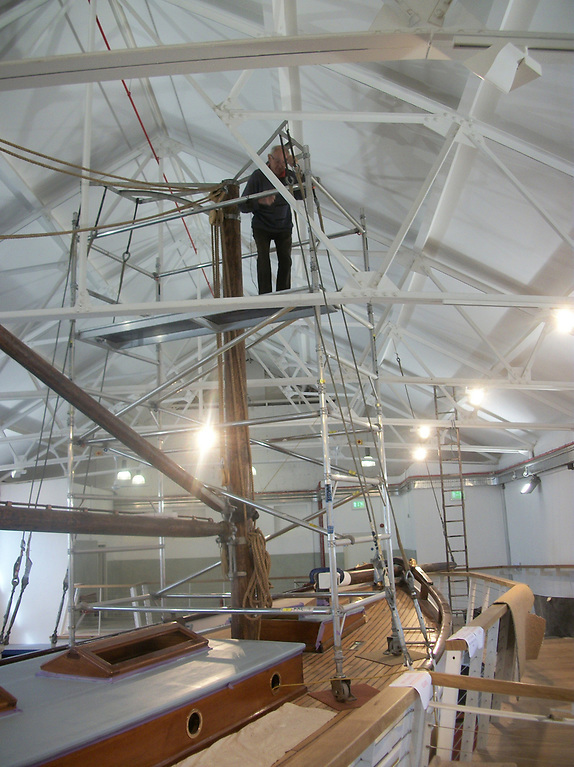
And then there was the matter of the Howth Yacht Club garden. For years, the 1987-completed Howth Yacht Club building had almost-impenetrable shrubbery on its landward side. But the General Committee were advised that this was increasingly a security and health hazard, so at a stroke the greenery was removed and replaced with a basic lawn and flower-beds.
Initially, how best to maintain this new arrangement became a matter of discussion at the traditional 11 o’clock coffee gathering of The Elders - including Neville – in the clubhouse each weekday morning. One particular morning, Neville said absolutely nothing, but he turned up in the afternoon with his lawnmower in the boot of his Micra, mowed the grass without a word, and maintained the habit thereafter, while his old friend and shipmate Gerry Sargent looked after the flowerbeds.
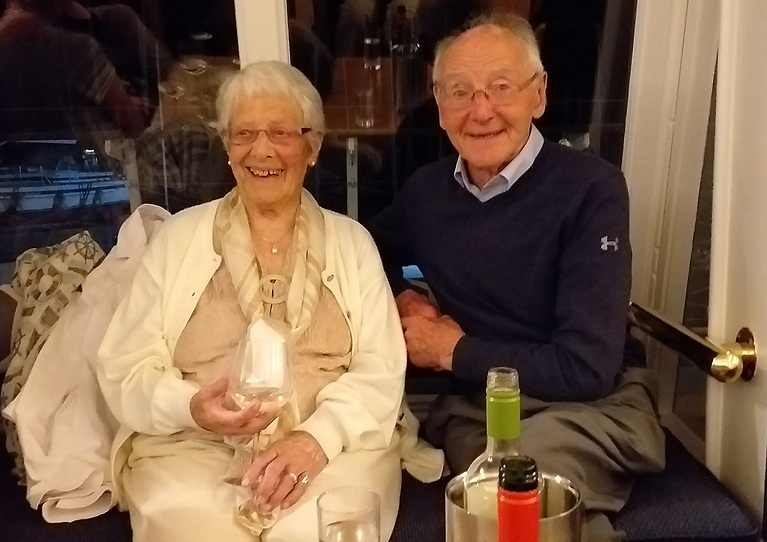
As Joe McPeake, HYC Commodore at the time was to put it, Neville Maguire was ultimately the complete gentleman, a doer of good works by such stealth that we’ll never know all of it. But that said, at his funeral on Thursday we further learned that the story of Neville Maguire the Secret Gardener extended to the flowerbeds and lawns of the Parish Church.
At 95, he had lived well, he lived the fullest possible life, and he lived it on his own self-contained but unselfish terms. Yet all who knew him now grieve mightily, and our heartfelt thoughts are with Jean and their remarkable family in their loss.
(Topmost photo: Never happier than when afloat – Neville Maguire aged 93 heading seawards from Howth in his final boat, the Seaward 23 Two Much
Credit: Conor Lindsay)
Written by WM Nixon, the article has been reproduced on hyc.ie with the kind permission of Afloat Magazine
Registered in the Republic of Ireland. Registered No. 81187
© Howth Yacht Club clg 2025 | web design & seo company - Isobar
